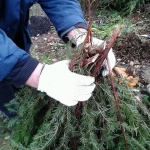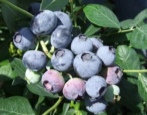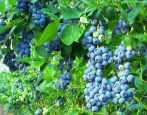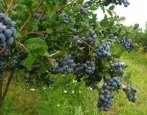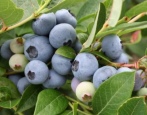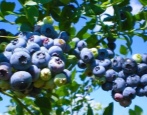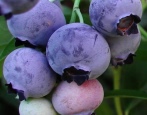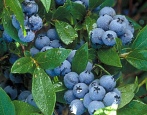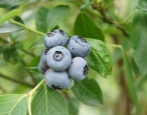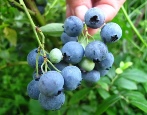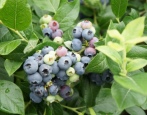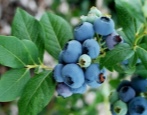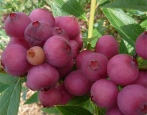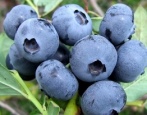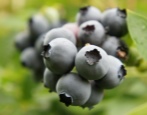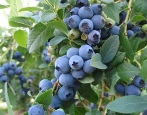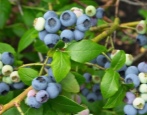
- Authors: USA
- Ripening terms: late ripening
- Growth type: tall
- Bush height, m: 1,5-2
- Taste: dessert, sweet
- Yield: high
- Average yield: 6-8 kg per bush
- Fruit size: medium and large
- Fruit shape: round
- Fruit color: light blue
Leadership in the production of tall blueberries belongs to the United States, because it was there that its cultivation began. The American Garden Blueberry Breeding Program has produced many excellent varieties. One of the old-timers of this program is Elliot Blueberry, the variety is still popular and has a high rating.
Breeding history
The Elliott cultivar was the result of the work of eminent pomologist George M. Darrow of Maryland by crossing Burlington and US1 and was given the original designation E-70. In 1948, the novelty was sent for testing in Michigan to the farm of Dr. Arthur Elliott, a famous breeder of blueberries, and was subsequently named after him. In 1973, the variety was brought into commercial use.
Description of the variety
Elliot is a garden late-ripening, tall (up to 2 m), self-fertile, productive blueberry variety with good immunity to diseases and frost resistance. Forms a powerful bush with upright strong woody shoots.
In the southern regions, the plant is valued for its high decorative effect: leaves of a dark green color with a blue tint remain on the branches for almost the whole year. The deciduous cover is renewed in spring, and in May the bushes are covered with light pink inflorescences with bell-shaped flowers.
The fruits are medium-sized (from 1.2 to 1.8 cm), light blue with an intense whitish waxy bloom, dense skin and a sweet taste. The crop is well stored and transported.
Fruit characteristics
Berries of the Elliot variety are round, slightly flattened, rather large (average diameter 1.4-1.6 cm, weight about 2 g), collected in loose elongated clusters. At the top of the berry there is a 4-5-toothed small cup. The skin is thin, firm and elastic. The pulp is juicy, jelly, white-green with small seeds. The juice does not stain the hands with pigment.
Taste qualities
Ripe berries have a dessert taste: they are sweet, with a delicate pleasant aroma. Astringency can be caused by cold and rainy summers.
First of all, the product is good fresh, with "live" vitamins (A, C, K, group B) and minerals. Blueberries are low in calories and high in beneficial anthocyanins and polyphenols.
You can make pies and desserts with blueberries, and for the winter you can make a five-minute jam, grind the berries with sugar (keep in the refrigerator), cook jam or compote. The beneficial properties of berries will be preserved when frozen in tightly closed containers or bags and stored in the freezer.
Ripening and fruiting
The harvest of this late variety is harvested from the second decade of August in the southern regions. In the central and northern regions, Elliot bears fruit from late August to early September. The berries ripen together, almost simultaneously.
The first crop from a bush can be obtained in the 2-3rd year after planting. Abundant fruiting begins in the 4-5th year of the plant's life.
Yield
One of the main advantages of the variety is its consistently high yield. An adult bush annually brings an average of 6 to 8 kg, competent agricultural technology helps to achieve 9 kg per bush.
The fruits do not crack, but they can peel off. The berries are dry when separated, and even those that have fallen do not deform.In commercial gardens, mechanized harvesting with a special harvester is possible. The crop perfectly withstands transportation without losses for presentation.
Self-fertility and the need for pollinators
The Elliot variety is self-fertile, but by replanting varieties with the same flowering time, you can achieve an earlier, harmonious and high yield. Cross-pollination is especially useful when grown in northern regions.
Growing and care
The shrub is vigorous and needs regular pruning. The process can be time consuming due to the height and density of the bush.
The variety is unpretentious, but there are nuances in the care:
you should use only mineral supplements, without organic matter;
the soil must be acidified with sulfur or a loose substrate must be prepared - sour peat, sand, coniferous humus;
mulching is mandatory (spruce needles, bark, sawdust);
watering - drip, directly to the root zone, with water without chlorine.
Elliot tolerates dry hot summers well and is quite frost-resistant, down to -26 ... 29 ° C. In colder winters, the bushes should be covered with air-permeable agrotextile.


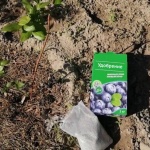
Disease and pest resistance
US breeders claim resistance to major diseases. But in the Russian Federation, Belarus, Ukraine, according to gardeners, Elliot can be affected by moniliosis, anthracnose and root rot, especially dampness and coolness affect this. From leaf rollers and aphids, the bushes are treated with insecticides.

